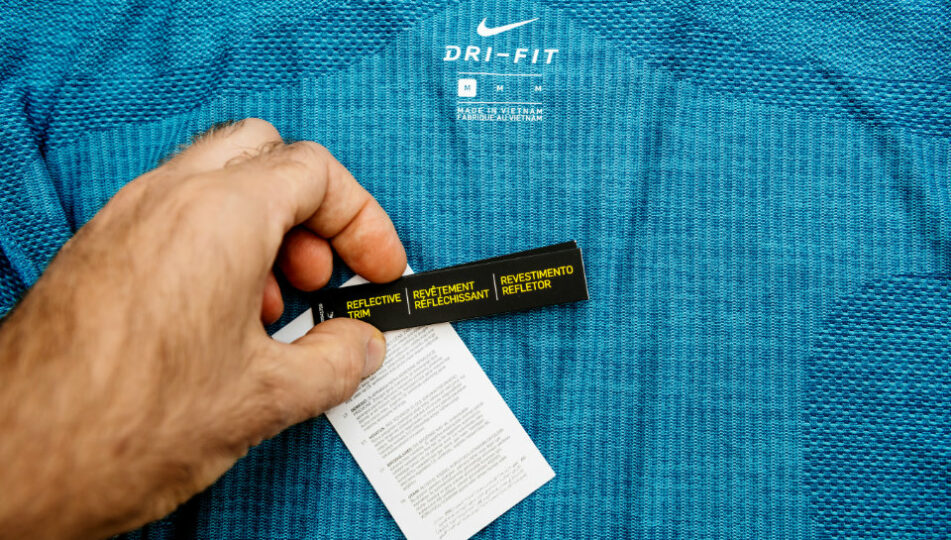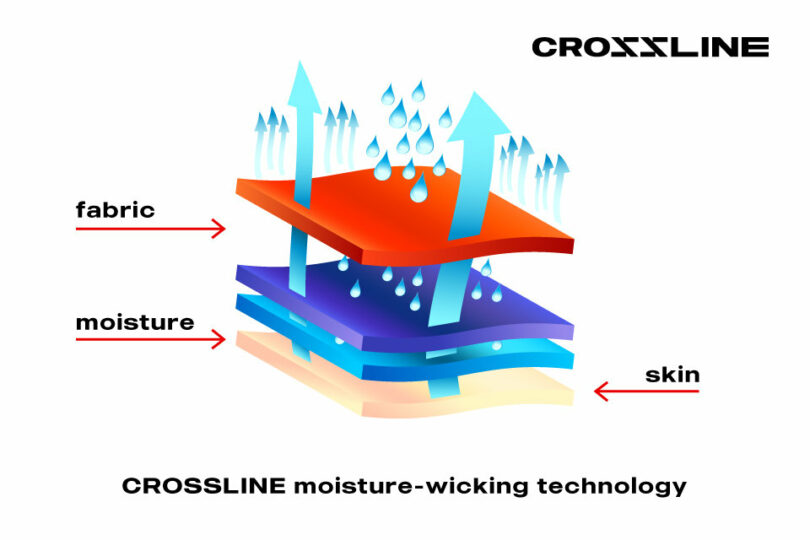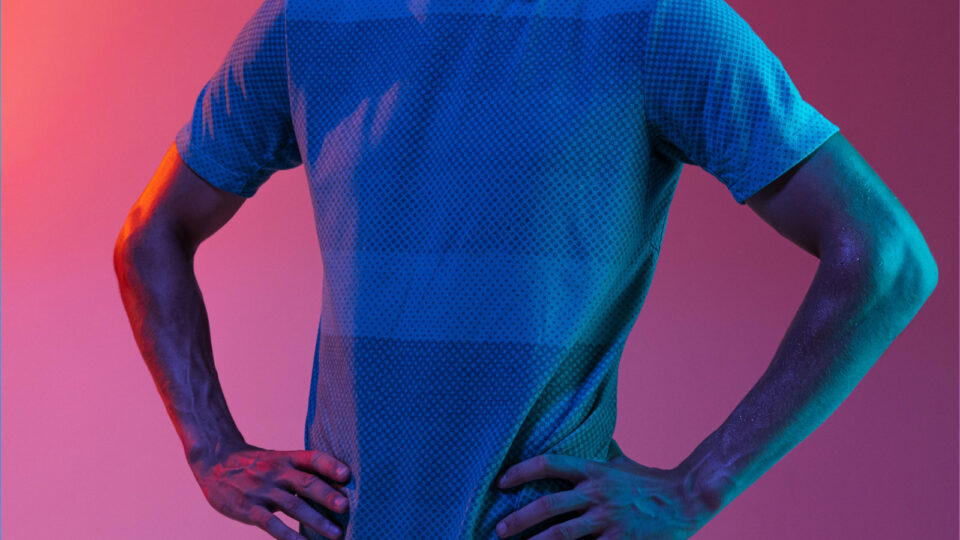Have you wear a Dri-FIT moisture-wicking shirt for your workout before? You’ve probably heard the term Dri-FIT before, but do you know what it really is?
Knowing how moisture-wicking fabrics like Dri-Fit can keep you cool and dry as you sweat can help you make better decisions when choosing the best running t-shirt.
After trying a moisture-wicking top during a sweaty workout, you’ll never want to wear a cotton tee again.
Let’s take a look at the science behind moisture-wicking workout shirts and how to choose the best moisture-wicking material.
What is Dri-FIT?
Dri-Fit Technology is a polyester fabric developed by Nike whose microfiber structure supports the body’s natural cooling system to keep you dry by wicking sweat and spreading it across the surface of the fabric where it can evaporate faster.
Several other apparel and sports companies offer similar products under different names.

What is Moisture-Wicking?
Moisture-wicking fabrics have two functions: quickly transport (wick) sweat to the outer surface of the fabric, and quickly wick sweat away so it doesn’t seep into the fabric.
You’ll end up feeling more comfortable because your body can effectively regulate temperature and the fabric that touches your skin feels dry and non-sticky.
In general, moisture-wicking is often related to the following terms:
- Moisture-Wicking: Clothing made of materials that do not absorb or retain moisture, eg synthetic materials such as nylon or polyester. There are some natural fibers that absorb moisture (such as merino wool and bamboo).
- Quick Drying: Moisture moves to the surface of the material, and when exposed to air, the material dries faster than traditional fabrics such as cotton.
- Breathable: The material allows air to pass through to prevent the air closest to your body from getting trapped, getting too hot and causing more sweat.
Any clothing that doesn’t absorb moisture can be considered moisture-wicking, so you need to make sure the product is also breathable.
It is interesting to note that just because a fabric is breathable doesn’t mean it dries quickly. So you’ll want to find a garment that’s made from a high-quality fiber that’s lightweight and soft to the touch, combined with just the right amount of moisture management to be both effective and comfortable.
How Dri-FIT and Other Moisture-Wicking Fabrics Work?
Moisture-wicking is based on “capillary action”, ie. the movement of a liquid (in this case, sweat) through tiny spaces within a fabric due to molecular forces between the liquid and the inner surface of the fabric.
Many brands such as Nike improve this process by carefully designing the structure of the yarns in the fabric and applying various treatments to the surfaces within that structure.
However, brands use various tests to measure wicking so there is no standard test that can be used for comparison.
Type of Moisture-Wicking Fabrics vs Dri-FIT
Synthetic Fabrics
Polyester is one of the world’s most popular textiles and is “hydrophobic,” which means they resist the penetration of water. It is strong and durable and are great at wicking moisture.
Polypropylene is a thermoplastic polymer like polyester. In addition to moisture wicking, polypropylene is quick-drying and prized for its thermal properties, making it ideal for cold-weather gear and apparel. It tends to retain odors and isn’t as soft as some of the other fabrics on this list.
Nylon is moisture-wicking, mildew-resistant and quick-drying. Thanks to its light weight and stretch, it’s perfect for activewear. However, the breathability of nylon depends on the size of the yarn or fabric.
Spandex, Lycra, or elastane is a lightweight, soft, smooth synthetic fiber with unique stretch properties. Due to its elastic properties, it is used to make stretchy clothes such as Yoga pants. Spandex isn’t breathable, but it’s “moisture-wicking,” which means it won’t show sweat, though it might help cause sweating.
Semi-Synthetic Fabrics
Micromodal is one of the most breathable, sweat-wicking semi-synthetic fabrics in use today. It has excellent temperature regulating properties so you can stay comfortable no matter the weather. Its super soft, silky texture makes it ideal for underwear, loungewear and all intimate apparel. However, mircomodal doesn’t trap heat and keep you warm and occasionally pills, which means it requires extra care than other moisture-wicking materials.
Bamboo is derived from plants, so its fibers are naturally moisture-wicking. Its soft and cool texture regulates body temperature well, making it perfect for year-round wear. However, moisture-wicking fabrics made from bamboo are more expensive than other natural fabrics like cotton.
Natural Fabrics
Wool absorbs small amounts of liquid into its fibrous core, but also wicks moisture out through the tiny holes in the fabric. The result is a wool yarn that feels dry on the surface. However, wool is not as soft as merino wool and can irritate sensitive skin. It is also not as durable as synthetic fabrics.
Merino Wool is one of the best moisture-wicking fabrics on the market today. It’s a natural fiber that’s lightweight, breathable and odor-free, making it perfect for warmer weather. However, merino wool is not as durable as cotton and other synthetic fabrics.
Fabrics to Avoid During Your Workout
Cotton is not suitable for running shirts or gym gear because it is a “moisture wicking” fabric. Cotton absorbs up to 7% of its weight in sweat and takes a long time to dry, leaving you feeling hot and sticky. On a cool rainy day, the humidity can make you colder.
Why Choose Moisture-Wicking Fabric For Your Running Shirts
Moisture-wicking fabrics are great for activewear because they help keep you dry when you start sweating from running, jogging or other physical activity.
That’s why it’s important to choose fabrics that wick moisture away from the skin, such as the Crossline’s AeroDRIFT and AeroWave.
Crossline has combined the power of all of these technologies to create the most affordable, breathable, moisture-wicking, odor- and sweat-resistant micromodal running tee on the market today.
If you work out and sweat a lot, that sweat evaporates and create a cooling effect. Your body stops sweating after your skin temperature has cooled to a comfortable level. It’s a super-efficient craft, complemented by moisture-wicking Crossline’s fabric.

How To Care For Moisture-Wicking Clothings
It’s recommended to read the washing and extra care instructions for most moisture-wicking garments when you want them to maintain the performance.
Here are some of the common washing guidelines:
- Machine wash inside out in cold water with like colours
- Don’t wring excess water
- Tumble dry or air dry on low heat
- Do not dry clean
- Do not use bleach, dryer sheets or fabric softener
- Iron on a cool setting if needed to avoid damaging the designs
- Use powdered detergent
What is Crossline?
Similarly like Nike Dri-FIT, Crossline’s fabric goes beyond ordinary polyester using a high-performance synthetic material which is hydrophobic, meaning it resists moisture very well.
Crossline’s AeroDRIFT and AeroWave feels thinner and lighter than regular polyester fabrics and is also specially treated to provide antimicrobial properties and UV protection.
The fibers do not absorb water or sweat, allowing moisture to escape through the tiny gaps between the threads. Once moisture reaches the exterior of the material, it spreads across the entire surface. From there it evaporates into the air.
Crosslines’s Fabric interlocking pebble surface also delivers excellent sweat-wicking property and is more durable than most natural fibers. Your workout gear will last a long time and without much wrinkling, staining, pilling, or fading while keeping you dry, comfortable and smelling fresh.
What type of clothing do you like to wear when working out? Have you tried Nike’s Dri-FIT or Crossline’s AeroWave or AeroWave before? Let us know by leaving a comment below!
More About Dri-FIT and Moisture-Wicking Fabrics
Is moisture wicking good?
Yes, the best way to stay dry and comfortable when you’re sweating is to wear clothing made with sweat-wicking/moisture-wicking fabric which uses capillary action to move sweat away from your body so it can evaporate and dry quickly.
What kind of fabric is moisture wicking?
Moisture-wicking fabrics include synthetic fibres such as polyester, polypropylene, Nylon, Spandex, Lycra, or elastane and semi-synthetic fibres like Micromodal and Bamboo and natural fibers like Merino Wool and Wool.
What are the benefits of moisture wicking?
Moisture-wicking fabrics can be good for:
- Keeping your body temperature regulated
- Preventing bacterial and fungal growth
- Preventing hypothermia
- Hiding excessive sweating
- Keeping you cool on hot days and nights
- Durable and easy to care for
What does Dri-FIT mean?
The official term Dri-FIT is a term created by Nike for their sportswear t-shirts. Nike Dri-FIT Technology is an innovative polyester fabric with moisture-wicking capability designed to help keep you dry.
What is Crossline fabric?
Crossline uses innovative polyester fabric which is lighter and thinner than regular polyester fabrics. It is designed to allow moisture to slide easily from the skin to the outer surface of the material to keep you cool and dry. It is also specially treated to provide antimicrobial properties and UV protection.





